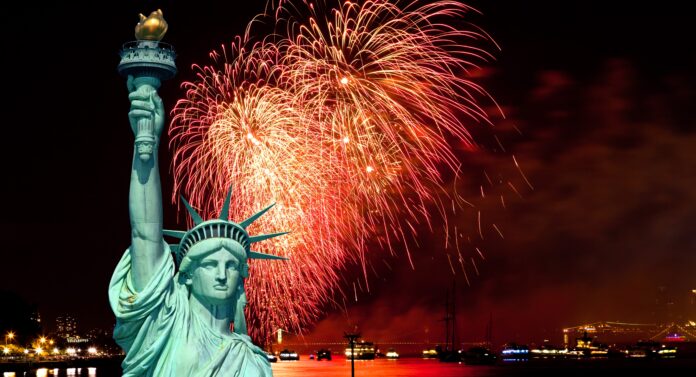By Sarah Wall
The Fourth of July tops many Americans’ lists of favorite holidays because it’s synonymous with summer. From backyard barbeques to neighborhood bike parades to an evening of lightning bugs and fireworks, Independence Day is truly an iconic holiday across the U.S.
But more than its celebrations, the Fourth of July ultimately commemorates 56 men’s signatures on the Declaration of Independence. Because their act of courage was also one of treason against Great Britain’s rule, it launched the Revolutionary War and, ultimately, the inception of the United States of America as an independent democratic republic. Over time, we showed the world how a “government of the people, by the people, for the people” can also become a beacon of hope for a better future for millions of people around the world.
There are few symbols that exemplify this message of Independence Day more than the Statue of Liberty, whose history is deeply intertwined not only with the holiday itself but with its significance as well.
Around 1865, French historian Edouard de Laboulaye proposed that France build and present a statue to the United States as a celebration of America’s successful, long-lasting democratic republic and a symbol of the friendship between the two countries. In his proposal, he hoped France would be able to present the gift in time for the 100-year mark of America’s independence on July 4, 1876.
The timing of de Laboulaye’s proposal was significant for more than just the approaching centennial. When he made his proposal, the American Civil War was coming to an end, and the French people likely sought to congratulate the nation’s leadership for holding the United States together even in the face of a devastating war. The French also knew better than most, not every attempt to establish a representative government was successful. Their own revolutionary project, the French Revolution, began just 13 years after the 1776 signing of the Declaration of Independence. When it ended ten years later, over 16,000 French citizens had been killed, and Napoleon Bonaparte, who declared himself emperor, had replaced the democratic institutions with his own rule. In 1865, France was still under the rule of Napoleon Bonaparte’s nephew, and since de Laboulaye was an advocate for democracy, he thought the project might spur French support for a new form of government of their own.
Ultimately, the French and the Americans partnered together to bring the Statue of Liberty concept to life. The commissioned sculptor, Frederic Auguste Bartholdi, would oversee the creation of the statue itself, and American architect Richard Morris Hunt would lead the building of the pedestal.
Because it was such an expensive endeavor—between the French and American obligations, the project cost about $500,000 in the 1880s money, which equates to nearly $15 million today—the French did not have the funds raised until 1875 when they began working on the project. The American-funded pedestal, though, took even longer, for neither Congress nor the New York state government decided to contribute any public funds. Only about half of the necessary $250,000 had been raised by 1885 when the French were nearly finished with the statue.
On March 16 of that year, Joseph Pulitzer, an immigrant from Hungary and publisher of one of the most popular New York City newspapers of the time, The World, asked his readers to send donations. “We must raise the money!” he wrote. “Let us not wait for the millionaires to give us this money. It is not a gift from the millionaires of France to the millionaires of America, but a gift of the whole people of France to the whole people of America.” Pulitzer’s words drew in about $100,000 in donations from readers, enough to finish the pedestal. Later that year, the Statue of Liberty made her way across the Atlantic in 200 crates. When she arrived in the New York Harbor, she was reassembled, placed on her pedestal, and dedicated by President Grover Cleveland on October 28, 1886.
On its base reads the famous words of Emma Lazarus, whose poem, “The New Colossus,” won a fundraising contest to raise donations for the pedestal. It reads, “Give me your tired, your poor / Your huddled masses yearning to breathe free / The wretched refuse of your teeming shore / Send these, the homeless, tempest-tossed to me / I lift my lamp beside the golden door!” For so many Americans, from 1886 until today, the Statue of Liberty represents this promise of America of independence, liberty, and democracy. On this and every Independence Day, we can look to her as a symbol of the strength that is behind us and within us, and in the future ahead.

Sarah Wall is a contributing writer for Smart Women Smart Money Magazine. For questions or comments, email [email protected].










